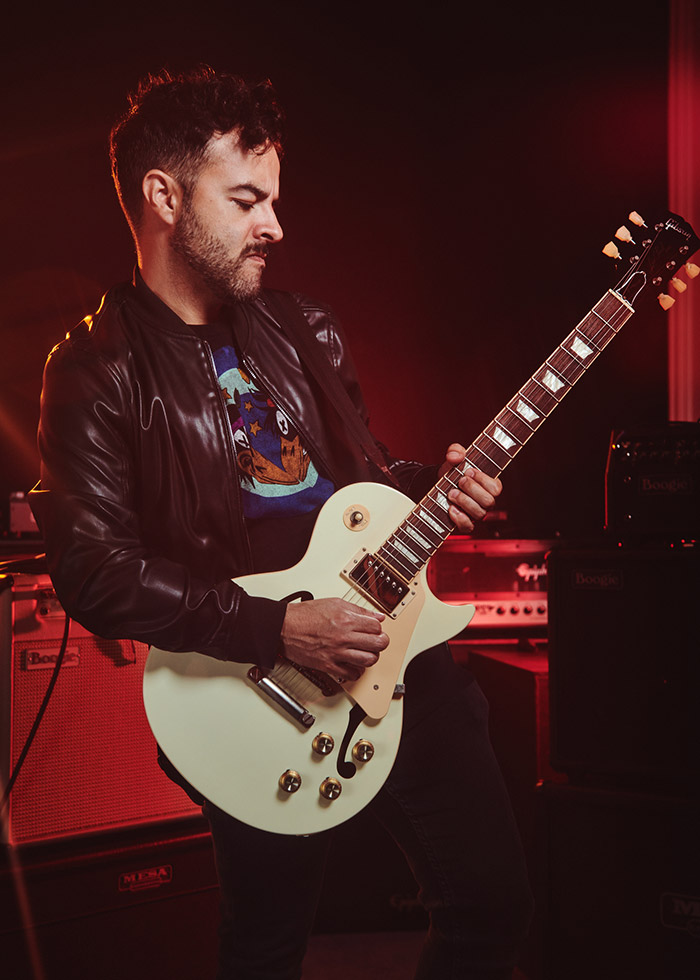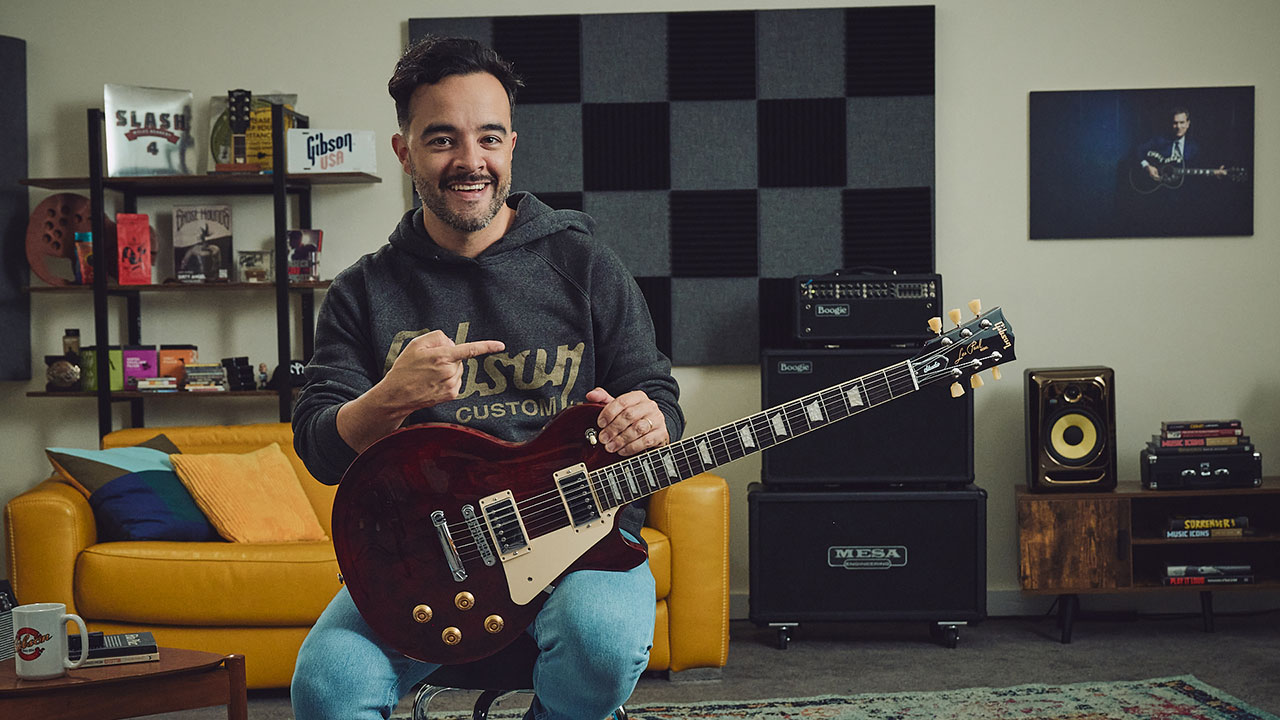Gibson TV en Español offers interviews, special performances, gear demos, and more
Are you an English-only speaker looking for a wonderful excuse to become bilingual? Obviously, Gibson is a global brand, but did you know that Gibson TV has expanded its reach toward 600 million Spanish speakers worldwide via Gibson TV en Español?
Gibson TV, the award-winning global online network from the iconic instrument brand Gibson, launched Gibson TV en Español last October. The platform brings original Spanish-language content focused on guitars, music, culture, and artists across Latin America, Spain, and Hispanic communities in the U.S.
Already delivering exciting interviews, special performances, and gear demos, the recently minted YouTube channel is poised to connect cultures through music. Even if you don’t speak Spanish, check out the gear demos for some tasteful playing—the music does the talking!
In the following interview, Juan Naranjo, LATAM/US Hispanic Special Projects Manager at Gibson, explains the mission of Gibson TV en Español. He describes some of his personal experiences that inspired the need for such a channel and how the very large Spanish-speaking musical audience is served by its existence. The interview is presented here in both Spanish and English—scroll down for the English version.
¿Cuál es la misión de Gibson TV en Español?
«Gibson TV en Español tiene, a mi modo de ver, dos propósitos principales. El primero es contar las historias de nuestros instrumentos en nuestro propio idioma. En este momento hay más de 600 millones de hispanohablantes en el mundo, incluyendo más de 40 millones de personas en Estados Unidos cuya lengua materna es el español. Cuando yo empecé a tocar guitarra, a mediados de los noventa, era muy difícil encontrar información disponible sobre los instrumentos que me interesaban y mucho más difícil encontrar información sobre estos instrumentos en mi idioma.
«De ahí viene la idea y la necesidad de contarle a nuestro público cuáles son las características y las especificaciones de los instrumentos, los amplificadores, los pedales y los equipos de nuestro grupo de marcas en español. El propósito es que no tengan que esforzarse—además—por entender el mensaje en un idioma diferente al suyo.
«El segundo, es darle visibilidad a los artistas de nuestra región. Tanto en Latinoamérica, como en España y en el mercado Hispano de Estados Unidos hay una cantidad de artistas talentosísimos y que tienen una relación de afinidad muy fuerte con Gibson, Epiphone, Kramer y todo nuestro grupo de marcas. Y creo que sus historias merecen un espacio en el ecosistema de medios de Gibson.»

Image: Juan at the Gibson Miami Showroom with the SJ-200 Studio Rosewood Satin Natural
¿Cómo logran obtener un balance entre el contenido técnico enfocado en los instrumentos y las historias de los artistas en el canal?
«Creo que todo se centra en la relación emocional que existe entre el público, los artistas y los instrumentos. El público desarrolla una relación muy emotiva con los artistas que admira, y los artistas tienen a su vez una relación emocional muy fuerte con sus instrumentos. El secreto, creo yo, está en contar las historias de los artistas y los instrumentos desde la emotividad, mencionando de paso por qué las características técnicas de los instrumentos son esenciales a la hora de hacer música.
«Yo, por ejemplo, empecé a desarrollar una relación de cariño muy fuerte por Epiphone cuando vi por primera a The Beatles tocando sus Casinos, y me interesé por Gibson cuando vi a Gustavo Cerati tocando una ES-335 en el MTV Unplugged de Soda Stereo, o cuando vi a The Edge tocando una versión íntima de Sunday Bloody Sunday usando una Les Paul Goldtop durante el Popmart Tour de U2. Entonces empecé a preguntarme: ¿Qué es lo que tienen esas guitarras? ¿Por qué estos músicos que admiro logran lo que logran con esos instrumentos? Para producir contenido musical interesante hay que apelar a lo informativo, pero también a lo emocional. Y eso es lo que estamos tratando de hacer en GTVE.»
¿Qué consejo le darías a un artista que esté tratando de hacer carrera en la industria musical e incluso llegar a aparecer en Gibson TV en Español?
«Sé que es un consejo que suena desgastado y cliché, pero es el mejor consejo que puede recibir un músico emergente y es: Encuentra tu propia voz, sigue tu propio camino, desarrolla tu propia forma de tocar, en vez de estar comparándote con lo que otros músicos están haciendo.
«En la era de las redes sociales es muy fácil perder el norte y distraerse con las tendencias pasajeras y los números de likes o streams. Mi consejo es que sigan su propio camino, que escuchen su instinto. Así van a ir encontrando los socios indicados para su trabajo.
«También les diría que la música es una carrera de resistencia, no de velocidad, que las cosas buenas toman tiempo y requieren esfuerzo. Y que no tengan miedo de tocar puertas. Yo, por ejemplo, entré en contacto con el equipo de Gibson por primera vez en 2007, cuando viajé a Nueva York a tocar con mi banda en el LAMC. En ese entonces conocí el showroom que había en Manhattan y nos prestaron instrumentos para ir a hacer un desconectado en las oficinas de Billboard. Las relaciones con Gibson—y con las marcas musicales en general—provienen generalmente de un interés genuino de parte del artista y de la marca.
«Como les digo siempre a los artistas con los que empezamos a trabajar en nuestra oficina en Miami: “El artista valida a la marca y la marca valida al artista”. Estas son relaciones de colaboración que vienen de un lugar emotivo, porque la música es arte y está conectada al corazón. Se parecen más a una amistad que a una transacción comercial.»
¿Cuáles son sus expectativas para el canal y su impacto en las generaciones músicas de artistas y amantes de la música?
«El interés del equipo es ayudar a difundir el mensaje de Gibson y de nuestros artistas en la región. Sé que esto es un negocio y que dependemos del crecimiento y del impacto del canal para medir el éxito del proyecto, pero si en unos años algún artista hispanohablante dice “Yo me interesé por la guitarra cuando vi un video de Gibson en YouTube”, me daré por bien servido.»

Image: Juan Naranjo, LATAM/US Hispanic Special Projects Manager, in action
What is the primary mission of Gibson TV en Español?
“Gibson TV en Español has, in my view, two primary purposes. The first is to share the stories of our instruments in our own language. Currently, there are over 600 million Spanish speakers worldwide, including more than 40 million people in the United States whose native language is Spanish. When I began playing guitar in the mid-90s, it was incredibly challenging to find information about the instruments I was interested in, and even more so to find that information in my language.
“This highlights the need to communicate to our audience the features and specifications of the instruments, amplifiers, pedals, and equipment from our brand group in Spanish, ensuring they don’t have to struggle to understand the message in a language that is not their own.
“The second purpose is to provide visibility to the artists from our region. In Latin America, Spain, and the Hispanic market in the United States, there are numerous incredibly talented artists with a strong affinity for Gibson, Epiphone, Kramer, and our entire brand group. I believe their stories deserve a prominent place in the Gibson media ecosystem.”
How do you balance the more technical, gear-focused aspects of guitar playing with storytelling and artist backgrounds within the content?
“I believe everything revolves around the emotional connection that exists between the audience, the artists, and the instruments. The audience develops a passionate relationship with the artists they admire, while the artists maintain a profound emotional bond with their instruments. The key, in my opinion, lies in narrating the stories of the artists and their instruments from an emotional perspective while also highlighting why the technical features of these instruments are essential for making music.
“For instance, I began to forge a strong emotional connection with Epiphone when I first saw The Beatles playing their Casino™ guitars. My interest in Gibson was sparked when I witnessed Gustavo Cerati performing on a Gibson ES-335™ during the MTV Unplugged of Soda Stereo, or when I saw The Edge delivering an intimate rendition of ‘Sunday Bloody Sunday’ using a Les Paul Goldtop during U2’s Popmart Tour. This led me to ponder, ‘What makes those guitars special? Why are these musicians I admire able to achieve such remarkable feats with those instruments?’ To create engaging musical content, one must appeal to both the informative and the emotional aspects. That’s precisely what we strive to accomplish at GTVE.”
What advice would you give aspiring musicians looking to break into the industry and potentially be featured on Gibson TV en Español?
“I know it may sound like a worn-out cliché, but it is truly the best advice a budding musician can receive: find your own voice, follow your own path, and develop your unique way of playing instead of comparing yourself to what other musicians are doing. In the age of social media, it’s all too easy to lose focus and get distracted by fleeting trends and the number of likes or streams. My advice is to stay true to your own journey and listen to your instincts. This way, you will discover the right partners along the way.
“I would also emphasize that music is a marathon, not a sprint; good things take time and require effort. Don’t hesitate to knock on doors. For example, I first connected with the Gibson team in 2007 when I traveled to New York to perform with my band at the LAMC. During that visit, I explored the showroom in Manhattan, where they generously lent us instruments for an unplugged session at the Billboard offices. Relationships with Gibson—and brands in general—often stem from a genuine interest on both the artist’s and the brand’s part.
“As I always remind the artists we begin working with at our Miami office: ‘The artist validates the brand, and the brand validates the artist.’ These are collaborative relationships that arise from an emotional place because music is art and is intrinsically connected to the heart. They resemble longterm friendships more than commercial transactions.”
What are your hopes for the channel’s longterm impact on fostering the next generation of guitarists and music lovers?
“The team’s interest is to help spread the message of Gibson and our artists in the region. I know this is a business, and we rely on the growth and impact of the channel to measure the success of the project, but if in a few years some Spanish-speaking artist says, ‘I became interested in the guitar when I saw a Gibson video on YouTube,’ then I will feel fulfilled.”
Gibson TV en Español is now streaming on YouTube, bringing high-quality content to Spanish-speaking audiences worldwide. Follow @gibsontvenespanol and be sure to subscribe for the latest updates.

